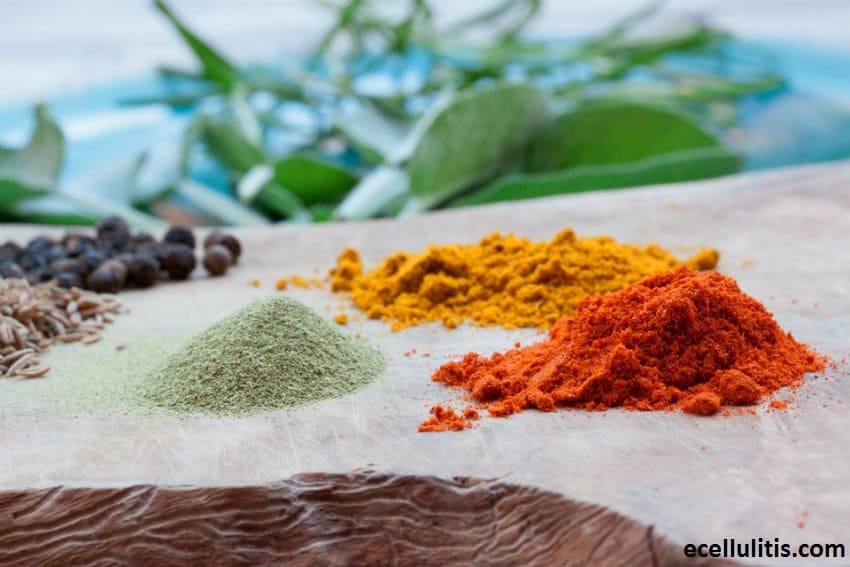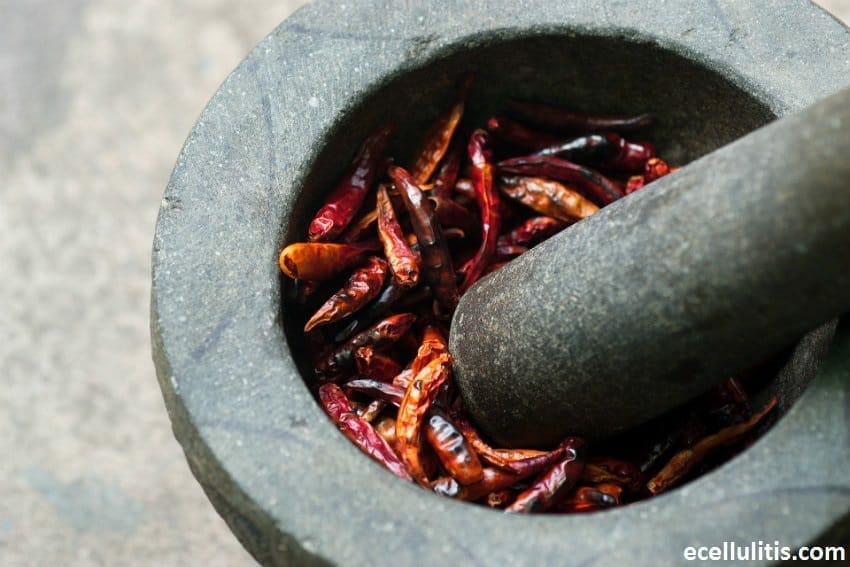Vitamin C In Paprika

Table of Contents
- What Is Paprika?
- The History of Paprika?
- The Most Commonly Used Types of Paprika
- Paprika vs. Chili Powder
- Why is paprika a health booster?
- Vitamin A
- Vitamin E
- Vitamin C
- Vitamin B6
- Vitamin K
- Iron
- Capsaicin
- Manganese, potassium, and magnesium
- What health benefits do we receive from consuming paprika? How can we boost our health?
- Energy
- Eye health
- Heart health
- Inflammatory diseases
- Blood pressure
- Diabetes
- Digestion
- Sleep
- Anemia
- Autoimmune Diseases
- Bacteria
- Cuts and wound healing
- Skin
- Hair
- Paprika Health Risks?
- Paprika Fun Facts
- How can you use paprika as a home remedy?
- How Do You Use Paprika?
Indian, Moroccan, and many European cuisines (Spanish, Austrian, and Hungarian) wouldn't be as delicious and enjoyable as they are if they did not include one secret ingredient, one powerful substance: paprika.
This spice is an important part of many continental savory dishes. We use it to add a sweet or mild-spicy kick to our food.
The spice's colors vary because the Capsicum annuum family of peppers include sweet bell peppers, hot red pepper, hot green peppers, and other varieties.
However, paprika is more than a tasty spice, more than just a pepper. Next to being a flavor enhancer, there are many health benefits of paprika, and we are going to name them all. But, before we start listing them, let's first get to know paprika.
What Is Paprika?

Paprika is, interestingly enough, the fourth most popular spice in the world, and can be found right next to the salt and pepper in most kitchen cabinets. Its taste can vary from sweet to hot. As we have previously mentioned, this spice is made from ground and dried peppers, more precisely from the Capsicum annuum species.
No matter which paprika you choose to use as a spice in your next dish, they all have many benefits. But, why are some paprikas hot and some not? Two factors affect the spiciness of paprika – the number of seeds, and the amount of inner flesh used in the manufacturing process. That being said, sweet paprika powder contains almost no seeds or membranes of the peppers. On the other hand, hot paprika powder contains seeds, placenta, and veins.
In Hungary, there are eight grades of paprika that are all categorized by color and heat. On the other hand, Spanish paprika is special because of the way it is created – before it turns to powder, peppers are smoke-dried.
The History of Paprika?
Paprika was first cultivated in the territories of Brazil and Bolivia. Thanks to Christopher Columbus, it found its way to Europe. As the story goes, they say Columbus brought chili paprika to Spain, offering it to the King and Queen. Soon after, paprika was cultivated in monasteries.
The interesting thing about the term "paprika" is that it is often used in non-English speaking territories across Europe to describe the pepper itself, not the powder.
The Most Commonly Used Types of Paprika

As was mentioned, paprika has many health benefits, and the best thing is that it can be used in so many different dishes. That being said, if you want to prepare a dish that requires paprika, you should know which paprika to use. Would you like to give your dish a sweet, subtle taste of paprika or spice it up as Hungarians do?
There are three most commonly used types of paprika.
The first type is sweet paprika, which doesn't provide heat to your dish. It can be used in a variety of meals, even for breakfast, as a topper on eggs. Without a doubt, it goes incredibly well with any meat.
If you want to add something spicier to your meal, then hot paprika is an excellent choice. We suggest using it when preparing goulash or paprikash. Both of these dishes are forms of stew and include meat.
The last type is, as you might have suspected, smoked paprika. This paprika powder comes in several versions – as mild, medium hot or hot. If you choose a mild version to include in the meal, you will, undoubtedly, notice the sweetness of the pepper. However, there is also a noticeable amount of smokiness.
Paprika vs. Chili Powder
Since there is a type of hot paprika, it can be confused with chili powder.
At first sight, these two spices look pretty much the same. However, if you look closely at them, you will notice the slight difference in color. Scent-wise, there is almost no difference at all. So, how can you tell them apart for sure?
First and foremost, remember that if your dish requires paprika or chili powder, you should use the precise ingredient. The difference between them is the pepper from which these powders are made.
Originally, chili powder is made from hot peppers, like jalapeños or bell peppers. Nowadays, in most cases, it is usually mixed with red paprika. On the other hand, the paprika powder is made from peppers found in Spain and Hungary.
Why is paprika a health booster?
If you ever wondered, "Is paprika good for me?" Stop wondering! There are many paprika health benefits.
Let's start with these:
Vitamin A
Paprika has several plant pigments, also known as carotenoids. These are beta-cryptoxanthin, beta-carotene, lutein and zeaxanthin. The first two are converted into vitamin A. All carotenoids function as antioxidants, preventing many chronic illnesses, and improving the immune system. Lutein and zeaxanthin are the primary antioxidants responsible for eye health. One teaspoon of paprika has 37 percent of the recommended daily intake of Vitamin A.
Vitamin E
An antioxidant that protects the body from damaging free radicals is another important vitamin that paprika contains. One teaspoon of paprika has 5 percent of the recommended daily intake of Vitamin E.
Vitamin C
Paprika is also an excellent source of Vitamin C – 117 milligrams per cup, which is more than twice the amount of Vitamin C found in an orange.
Vitamin B6
Paprika is rich in this coenzyme that initiates biochemical reactions responsible for creating glucose and the production of neurotransmitters. Vitamin B6 lowers the chance of developing cardiovascular diseases. Since this vitamin aids in the production of melanin, a pigment that gives color to the hair, it is no surprise that paprika has this kind of superpower. One teaspoon of paprika has 4 percent of the recommended daily intake of Vitamin B6.
Vitamin K
Another perk on the list of paprika health benefits is the fact it contains 4.5 percent of the daily recommendation of Vitamin K for adult men and 6 percent for women. This nutrient is beneficial for the growth and development of the bones. Therefore, taking in Vitamin K regularly lowers the risk of getting osteoporosis or bone fracture. On another matter, Vitamin K has a role in proper blood coagulation. So, next time you cut yourself while preparing your meal, and notice you are bleeding excessively, opt for the paprika.
Iron
Iron is a mineral responsible for carrying oxygen through the body and creating energy in organisms. From one teaspoon of paprika, women get 3 percent of their daily recommended intake, while men get 6 percent.
Capsaicin
Capsaicin – an active ingredient that causes the heat in chili peppers. Relaxes blood vessels, lower blood pressure and is very beneficial as a pain reliever. Paprika has a lower amount of capsaicin in comparison to cayenne pepper, but still a valuable amount.
Manganese, potassium, and magnesium
Paprika has a great amount of these important minerals: one cup of paprika has 0.10 milligrams of manganese, 194 milligrams of potassium, and 11 milligrams of magnesium.
The color of the bell peppers can show you which nutrients they contain. For instance, if they are yellow, they have a high amount of lutein and zeaxanthin; if red, they have astaxanthin and lycopene; if orange, they are rich in alpha, beta and gamma-carotene; and if purple, these bell peppers are rich in anthocyanin.
What health benefits do we receive from consuming paprika? How can we boost our health?

Energy
Vitamin B6 is vital in enabling hundreds of other enzymes to perform their functions in the body. These other enzymes initiate biochemical processes in the body, creating energy, and providing glucose. Another important nutrient for creating energy is iron, which carries oxygen throughout the body. However, when it comes to iron, there is one thing you have to remember – paprika doesn't contain the form of iron, which is easily absorbed in the body.
So, if you want to increase the amount of iron you get from paprika, be sure to include meat or Vitamin C in the paprika dish. Remember, this spice contains 1.44 milligrams of iron per tablespoon. To put this number in perspective, adult men need 8 milligrams of iron daily, while women need 18 milligrams. Paprika is known as a stimulant and energizer and can be used to treat tiredness, lethargy, and depression.
Eye health
As mentioned, paprika contains carotenoids, which are important for eye health. When converted into Vitamin A, this vitamin is used by the eyes to turn light into vision. In particular, carotenoids, lutein, and zeaxanthin reduce the risk of developing cataracts and age-related macular degeneration.
Heart health
Essential vitamins and minerals in paprika protect against cardiovascular diseases. That is a heart attack and stroke. Vitamin E reduces the risk of heart disease by preventing damage caused by free radicals. Iron, magnesium, and potassium help purify the blood and improve heart health.
Inflammatory diseases
Paprika is particularly beneficial for people who suffer from inflammatory and autoimmune diseases. It can help relieve swelling caused by arthritis and relieve other pains in the body.
Blood pressure
Due to capsaicin, paprika helps lower blood pressure because this compound relaxes the blood vessels.

Diabetes
Although there are numerous health benefits of paprika, it cannot cure diabetes. Nevertheless, it can do wonders by improving the way sugar is processed in the blood. Once again, capsaicin has proven to be one of the greatest nutrients in paprika. So, if you are not a fan of cinnamon, which also lowers the blood sugar level, you can always opt for paprika.
Digestion
Paprika is a stimulant, and aids in digestion by normalizing acid in the stomach and boosting saliva. It is often used to treat indigestion.
Sleep
Paprika promotes healthy sleep due to Vitamin B6, which has powerful psychological and neurological effects. This vitamin contributes to the production of melatonin, "sleep hormone," helping with the normal sleep cycle. It also boosts the body's levels of serotonin and norepinephrine, stress-reducing hormones.
Anemia
Iron is involved in the formation of red blood cells, and Vitamin C enables the body to absorb iron. Including paprika in your diet helps prevent anemia.
Autoimmune Diseases
According to a 2016 study, capsaicin, which determines how hot the paprika gets, is a powerful tool for fighting autoimmune diseases. As the authors stated, autoimmune conditions are not curable, but paprika can serve as part of the therapy. Why does it have a chance? Because capsaicin contributes to activating receptors that produce biological effects. These effects are proven to be beneficial in treating these types of conditions.
Bacteria
Paprika has antibacterial properties – a protein found in paprika inhibits the growth of certain bacteria, such as E. coli and Salmonella. These bacteria are often transferred through ingestion, thus, including paprika in your diet helps inhibit their growth. Additionally, antibacterial properties are also manifested as skin benefits. So, if you are experiencing bacterial acne, be sure to add paprika to your diet. Also, if you are thinking about placing paprika directly on acne, please avoid trying it, since it can irritate the skin.
Cuts and wound healing
Vitamin E helps form clots in case of cuts and wounds, because it helps in the production of red cells.

Skin
Paprika prevents the occurrence of freckles and age spots due to the rich content of vitamins, beta-carotene and iron. Vitamin A prevents the appearance of wrinkles, free lines and sagging skin, and promotes a bright complexion. If you are interested in brightening your skin, be sure to check Stylecraze.com's post. Along with paprika, you'll need only one ingredient – honey.
Hair
We mentioned that paprika can maintain your natural hair color. What you may not know is that Vitamin B6 also prevents hair loss, iron helps transfer oxygen to hair follicles, and it stimulates hair growth by improving circulation.
Paprika Health Risks?
Although paprika is considered to be a powerful natural remedy for multiple diseases, there is just one risk we have to mention: Some people are allergic to paprika.
According to the study Paprika rhinoconjunctivitis case reveals new occupational Capsicum allergens, this type of allergic reaction can only occur if you work in an environment in which you have touched and consumed multiple spices, not just paprika, in a short period.
Besides causing an allergic reaction, paprika is most likely not going to be responsible for any other medical conditions. In fact, according to Livestrong.com, a study from 2003 suggests that rats that were given a diet containing up to 5 percent of paprika, had higher cholesterol levels. However, the rats did not have any other health issues. We can safely say that you can consume and enjoy paprika moderately, just like you would any other spice.
Paprika Fun Facts

Here are some fun facts you probably didn't know about paprika:
• In the Hungarian town of Kalocsa, there is a Paprika Museum. In this museum, you can learn about planting, growing, and harvesting paprika. Additionally, you can get a sneak peek of how the manufacturing process behind Hungarian paprika really works. Sounds interesting, doesn't it?
• To preserve the taste and smell of peppers before turning them into paprika powder, you should keep them in the dark and cold place.
• In Europe, especially in Hungaria, there is a custom to hang peppers on the house fence of a house in the time of harvesting.
How can you use paprika as a home remedy?
If you have cold feet, you can cut up bell peppers and put them in your socks. The "mildly hot" peppers will keep your feet warm.
If you notice symptoms of a sore throat, gargle the juice made from bell peppers, it has excellent antiseptic properties.
For nose bleeding, you can use the rich amount of Vitamin C to help heal and repair the lining of the mucous membranes, and to prevent the nose from bleeding. For better effect, you can mix the juice from bell peppers with lotus root juice.
Paprika adds a distinct flavor to a dish, and if you are not sure how to include paprika in your nutrition, you can learn how to prepare chicken paprikas.

How Do You Use Paprika?
As you can see, there are many health benefits of paprika. The greatest thing about it is that it can be used in multiple ways and in a variety of dishes. For example, I like to add it when creating my chocolate dessert. Chocolate and paprika create a harmonious taste.
How do you most often use paprika? Have you noticed some other paprika health benefits we didn't mention? Be sure to share it in the comment section below.
Last article update: 10/4/2018
Image by 123Rf Photo Stock and Pixabay.com
Source: https://www.ecellulitis.com/12-amazing-health-benefits-of-paprika/

0 Komentar